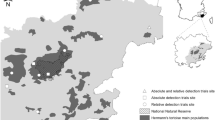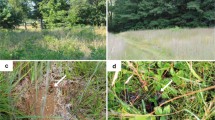Abstract
Bumblebee nests are difficult to find, hampering ecological studies. Effective population size of bumblebees is determined by nest density, so the ability to quantify nest density would greatly aid conservation work. We describe the training and testing of a dog to find bumblebee nests. The dog was trained by the British army, using B. terrestris nest material. Its efficacy in finding buried nest material of a range of bumblebee species was 100%, and no false positives were recorded, suggesting that the dog was able to generalize across Bombus species. The dog was then used to locate bumblebee nests in four different habitats on the island of Tiree, west Scotland. The dog located 33 nests, and nest densities recorded varied from 0 to 1.86 nests per hectare, according to species and habitat. Habitat preferences appeared to be evident among the bumblebee species, with most B. muscorum nests in machair and all of the B. distinguendus nests being in dunes. We conclude that the technique has great potential, but note that using a dog to detect nests in more densely vegetated habitats may be less successful.
Similar content being viewed by others
References
Brooks S.E., Oi F.M., Koehler P.G. (2003) Ability of Canine termite detectors to locate live termites and discriminate them from non-termite material, J. Econ. Entomol. 96, 1259–1266.
Cameron S.A., Hines H.M., Williams P.H. (2007) A comprehensive phylogeny of the bumble bees (Bombus), Biol. J. Linn. Soc. 91, 161–188.
Chapman R.E., Wang J., Bourke A.F.G. (2003) Genetic analysis of spatial foraging patterns and resource sharing in bumble bee pollinators, Mol. Ecol. 12, 2801–2808.
Darvill B., Ellis J.S., Lye G.C., Goulson D. (2006) Population structure and inbreeding in a rare and declining bumblebee, Bombus muscorum (Hymenoptera: Apidae), Mol. Ecol. 15, 601–611.
Darvill B., Knight M.E., Goulson D. (2004) Use of genetic markers to quantify bumblebee foraging range and nest density, Oikos 107, 471–478.
Dematteo K.E., Rinas M.A., Sede M.M., Davenport B., Arguelles C.F., Lovett K., Parker P.G. (2009) Detection Dogs: An Effective Technique for Bush Dog Surveys, J. Wildl. Manage. 73, 1436–1440.
Ellis J.S., Knight M.E., Darvill B., Goulson D. (2006) Extremely low effective population sizes, genetic structuring and reduced genetic diversity in a threatened bumblebee species, Bombus sylvarum (Hymenoptera: Apidae), Mol. Ecol. 15, 4375–4386.
Fussell M., Corbet S.A. (1992) The nesting places of some British bumblebees, J. Apic. Res. 31, 32–41.
Goulson D. (2010) Bumblebees; their behaviour, ecology and conservation, Oxford University Press, Oxford.
Goulson D., Hughes W.O.H., Derwent L.C., Stout J.C. (2002) Colony growth of the bumblebee, Bombus terrestris, in improved and conventional agricultural and suburban habitats, Oecologia 130, 267–273.
Goulson D., Lye G.C., Darvill B. (2008) Decline and conservation of bumblebees, Annu. Rev. Entomol. 53, 191–208.
Helton W.S. (2009) Canine ergonomics: the science of working dogs, CRC Press, Boca Raton.
Knight M.E., Martin A.P., Bishop S., Osborne J.L., Hale R.J., Sanderson R.A., Goulson D. (2005) An interspecific comparison of foraging range and nest density of four bumblebee (Bombus) species, Mol. Ecol. 14, 1811–1820.
Kosior A., Celary W., Olejnikzak P., Fijal J., Krol W., Solarz W., Plonka P. (2007) The decline of the bumble bees and cuckoo bees (Hymenoptera: Apidae: Bombini) of Western and Central Europe, Oryx 41, 79–88.
Long R.A., Donovan T.M., Mackay P., Zielinski W.J., Buzas J.S. (2007) Effectiveness of scat detection dogs for detecting forest carnivores, J. Wildl. Manage. 71, 2007–2017.
Macdonald M., Nisbet G. (2006) Highland bumblebees, Highland Biological Recording Group, Inverness.
Osborne J.L., Martin A.P., Shortall C.R., Todd A.D., Goulson D., Knight M.E., Hale R.J., Sanderson R.A. (2008) Quantifying and comparing bumblebee nest densities in gardens and countryside habitats, J. Appl. Ecol. 45, 784–792.
Sladen F.W.L. (1912) The Humble-bee, its Life History and how to Domesticate it. Including The Humble Bee (1892), Logaston Press, London.
Wallner W.E., Ellis T.L. (1976) Olfactory detection of gypsy moth pheromone and egg masses by domestic canines, J. Econ. Entomol. 5, 563–565.
Author information
Authors and Affiliations
Corresponding author
Additional information
Manuscript editor: Peter Rosenkranz
Rights and permissions
About this article
Cite this article
Waters, J., O’Connor, S., Park, K.J. et al. Testing a detection dog to locate bumblebee colonies and estimate nest density. Apidologie 42, 200–205 (2011). https://doi.org/10.1051/apido/2010056
Received:
Revised:
Accepted:
Published:
Issue Date:
DOI: https://doi.org/10.1051/apido/2010056




